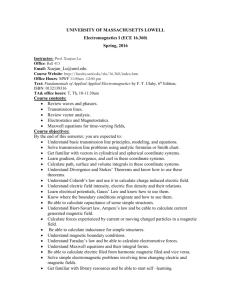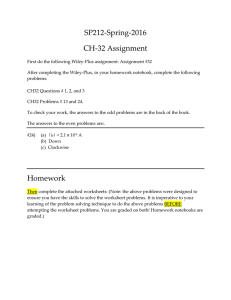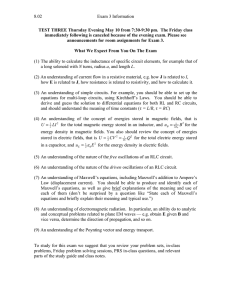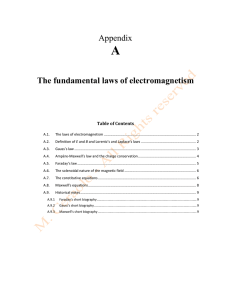Fields and Waves (ECE230)
advertisement
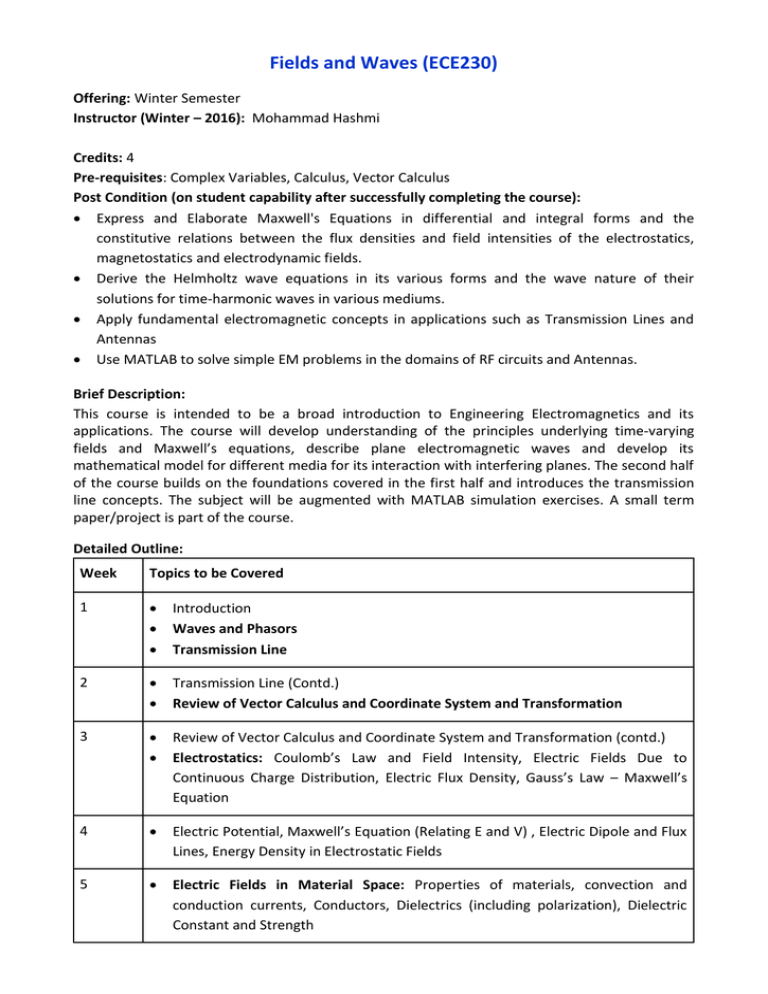
Fields and Waves (ECE230) Offering: Winter Semester Instructor (Winter – 2016): Mohammad Hashmi Credits: 4 Pre-requisites: Complex Variables, Calculus, Vector Calculus Post Condition (on student capability after successfully completing the course): Express and Elaborate Maxwell's Equations in differential and integral forms and the constitutive relations between the flux densities and field intensities of the electrostatics, magnetostatics and electrodynamic fields. Derive the Helmholtz wave equations in its various forms and the wave nature of their solutions for time-harmonic waves in various mediums. Apply fundamental electromagnetic concepts in applications such as Transmission Lines and Antennas Use MATLAB to solve simple EM problems in the domains of RF circuits and Antennas. Brief Description: This course is intended to be a broad introduction to Engineering Electromagnetics and its applications. The course will develop understanding of the principles underlying time-varying fields and Maxwell’s equations, describe plane electromagnetic waves and develop its mathematical model for different media for its interaction with interfering planes. The second half of the course builds on the foundations covered in the first half and introduces the transmission line concepts. The subject will be augmented with MATLAB simulation exercises. A small term paper/project is part of the course. Detailed Outline: Week Topics to be Covered 1 Introduction Waves and Phasors Transmission Line 2 Transmission Line (Contd.) Review of Vector Calculus and Coordinate System and Transformation 3 Review of Vector Calculus and Coordinate System and Transformation (contd.) Electrostatics: Coulomb’s Law and Field Intensity, Electric Fields Due to Continuous Charge Distribution, Electric Flux Density, Gauss’s Law – Maxwell’s Equation 4 Electric Potential, Maxwell’s Equation (Relating E and V) , Electric Dipole and Flux Lines, Energy Density in Electrostatic Fields 5 Electric Fields in Material Space: Properties of materials, convection and conduction currents, Conductors, Dielectrics (including polarization), Dielectric Constant and Strength 6 Continuity Equation and Relaxation Time, Boundary Conditions Electrostatic Boundary Value Problems: Poisson’s and Laplace’s Equations, Uniqueness Theorem, Solution for Poisson’s and Laplace’s Equations Resistance and Capacitance 7 Magnetostatic Fields: Biot-Savart Law, Ampere’s Circuital Law, Applications of Ampere’s Law Magnetic Flux Density, Magnetic Scalar and Vector Potentials, Magnetic Torque and Moment, Magnetic Dipole 8 Magnetization in Materials Magnetic Boundary Value Problems Inductors and Inductances, Magnetic Energy, Magnetic Circuits 9 Maxwell’s Equations: Faraday’s Law, Displacement Current, Maxwell’s Equations in Differential and Integral Forms Power and Poynting Vectors, Time-Varying Potentials, Time-Varying Fields 10 Wave Propagation in Lossy Dielectrics, Plane Waves in Free Space and Good Conductors 11 Reflection of Plane Waves at Normal Incidence and Oblique Incidence 12 & 13 Radiation and Antenna Text Book: Principles of Electromagnetics 4th Edition, Mathew N. O. Sadiku. Reference Book: Electromagnetic Field and Waves 2nd Edition, David K. Cheng. Fundamentals of Applied Electromagnetics 6th Edition, Fawwaz T. Ulaby Engineering Electromagnetics with MATLAB 2nd Edition, Karl E. Lonngrenn et al. Methodology: Class lectures will be power point slides based and may be augmented by supplementary resources such as video lectures and/or traditional chalk and board MATLAB simulations will be incorporated to help students in understanding the concepts Evaluation: Class-Test (all compulsory): 20%; Home Assignments (all compulsory): 20% Mid-sem: 25%; End-sem: 25% Project: 10% Plagiarism Policy: As per the institute guidelines
